

Divine Women: When God was a Girl. Uk.businessinsider. Women in World History: PRIMARY SOURCES: South Asia. Internet History Sourcebooks Project. This page is a subset of texts derived from the three major online Sourcebooks listed below, along with added texts and web site indicators.
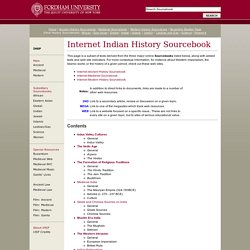
For more contextual information, for instance about Western imperialism, the Islamic world, or the history of a given period, check out these web sites. There is now some significant opposition among some writers to the idea that there was ever an Aryan [i.e. Indo-European] movement into India. This opposition seems to derive, at least in part, from nationalist desires to claim "we were always here". The linguistic arguments for some common group which moved into both India, Iran, and Europe remain compelling.
General WEB Medieval India (600 BCE - 1526 AD) [Internet Archive] With links ot other site and art images. South Asia Resources. A Green Revolution Lesson. Overview This lesson would fit into a unit on development and has been designed to provide an example of how development technology created by the West is implemented in a developing country.

This lesson is a simulation of the implementation of the Green Revolution in two villages in Northwest India in the late 1960s as the new seeds first started to appear on the world scene. The simulation has preserved actual circumstances wherever possible. Authors: Kathleen C. 'Green Revolution' Trapping India's Farmers In Debt. Is the Hijab Worth Fighting Over? - Room for Debate. India’s Muslim Population. Introduction Although home to a Hindu majority, India has a Muslim population of some 150 million, making it the state with the second-largest Muslim population in the world after Indonesia.
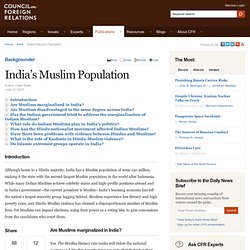
While many Indian Muslims achieve celebrity status and high-profile positions abroad and in India’s government—the current president is Muslim—India’s booming economy has left the nation’s largest minority group lagging behind. Muslims experience low literacy and high poverty rates, and Hindu-Muslim violence has claimed a disproportionate number of Muslim lives. Yet Muslims can impact elections, using their power as a voting bloc to gain concessions from the candidates who court them. Are Muslims marginalized in India? Yes. Are Muslims disadvantaged to the same degree across India? No. History and Politics, Partition of India. The partition of India is a signal event in world history, not merely in the history of the Indian subcontinent.
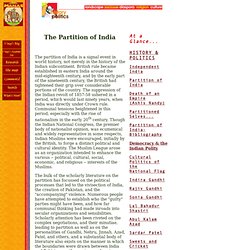
British rule became established in eastern India around the mid-eighteenth century, and by the early part of the nineteenth century, the British had tightened their grip over considerable portions of the country. The suppression of the Indian revolt of 1857-58 ushered in a period, which would last ninety years, when India was directly under Crown rule. Communal tensions heightened in this period, especially with the rise of nationalism in the early 20th century. Though the Indian National Congress, the premier body of nationalist opinion, was ecumenical and widely representative in some respects, Indian Muslims were encouraged, initially by the British, to forge a distinct political and cultural identity. The Muslim League arose as an organization intended to enhance the various -- political, cultural, social, economic, and religious -- interests of the Muslims.
The Road to Partition 1939-47. The end of the British Empire in India in August 1947 resulted in the creation of two separate states of India and Pakistan.
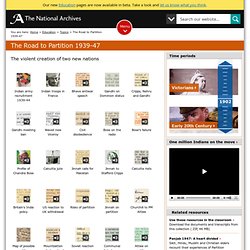
The division was based on religious lines, a Muslim majority in Pakistan and a Hindu majority in India. Pakistan itself was split into two parts in the east (East Bengal, which became Bangladesh in 1971) and in the west (western Punjab). This event was to result in the biggest mass migration in history. Over 18 million people migrated to join their particular religious majority. At least a million people died in communal violence in the process. There is much historical debate as to why partition was accompanied by so much bloodshed.
The British promised to leave India by July 1948, but the Viceroy Louis Mountbatten moved this forward to August 1947. Rang De Basanti (2006. British Empire. The National Archives Learning Curve. Home - Human-Environment Interactions in India. Faith and Doubt at Ground Zero. Aired: 09/03/200201:54:03Rating: NR For many Americans, the most difficult questions about 9/11 were not about politics, military strategy or homeland security. They were questions about God, about evil and about the potential for darkness within religion itself. What was it we saw on Sept. 11? Was it the true face of evil? Was it... Faith and Doubt at Ground Zero One year after 9/11 how did America grapple with its biggest and most difficult questions? Through Ad Campaign, Muslim Activists Want To Redefine 'Jihad' : The Two-Way. Hide captionOne of the ads running in the Washington, D.C. metro.
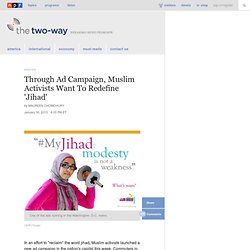
CAIR-Chicago One of the ads running in the Washington, D.C. metro. Buddhism. Religion & Ethics - In pictures: Buddhist Wheel of Life. The Ganges: A Journey into India. Www.bbc.co.uk/radio4/today/galleries/3357/1/#gallery3357. Religion: Hinduism. How India's Success Is Killing the Ganges. In a pine-scented Himalayan valley, Sushila Devi is a reluctant soldier in India's new war over water.
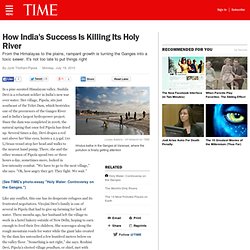
Her village, Pipola, sits just southeast of the Tehri Dam, which bestrides one of the precursors of the Ganges River and is India's largest hydropower project. Since the dam was completed in 2006, the natural spring that once fed Pipola has dried up. Several times a day, Devi drapes a red sari above her blue eyes, hoists a 2.5-gal. (10 L) brass vessel atop her head and walks to the nearest hand pump. There, she and the other women of Pipola spend two or three hours a day, sometimes more, locked in low-intensity combat. "We have to go to the next village," she says. Like any conflict, this one has its desperate refugees and its frustrated negotiators. Battles like the one in Pipola are festering all over India. Following the Ganges (known as Ganga to Indians) from the Himalayas to Varanasi, 600 miles (965 km) downstream, I saw this tension play out in countless ways. Power for the Women of India - Room for Debate. On Tuesday, Indian students protested against a Hindu nationalist who said a gang-rape victim was as responsible as her attackers.
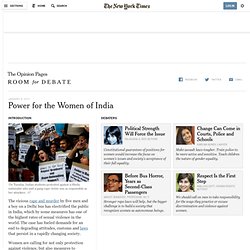
AP The vicious rape and murder by five men and a boy on a Delhi bus has electrified the public in India, which by some measures has one of the highest rates of sexual violence in the world. The case has fueled demands for an end to degrading attitudes, customs and laws that persist in a rapidly changing society. Women are calling for not only protection against violence, but also measures to overcome inequality. How can Indian women gain power so they would not only be safe, but also have more say in their nation’s future?
In pictures: Desperate battle to save India's children. A Personal Account of Partition - Sammy Bhatia '15. Jati: The Caste System in India. Travelers to India have commented on caste for more than two thousand years. In Indian society the group comes first, unlike our own society that gives so much importance to the individual personality. After a person’s family, the caste commands an individual’s major loyalty. Indians still often identify themselves by the community they belong to and caste is still a factor in marriage selection. In addition, caste has allowed countless groups that have migrated into India to find a place and to play an important role. India Advances, but Many Women Still Trapped in Dark Ages.
Religion and Human Rights (10b): The Indian Caste System. (source) In India, a caste is a hereditary group in a traditionally and rigidly stratified society.
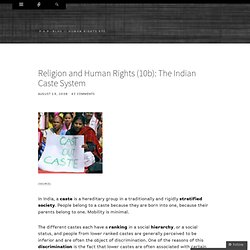
People belong to a caste because they are born into one, because their parents belong to one. Mobility is minimal. The different castes each have a ranking in a social hierarchy, or a social status, and people from lower ranked castes are generally perceived to be inferior and are often the object of discrimination. The Oldest Religion Is Hinduism - The Only Uncreated & Self-Existing "Vedic Religion" Of India/World.
08.08.07. Interactive. Anniversary of the partition of india. Watch / The Bhagavad Gita / Invitation to World Literature. Invitation to World Literature: The Bhagavad Gita Video Transcript Glass: The thing that's most striking about the Gita is the degree of focus that it brings to a very simple question.

Action and inaction, what is the best thing to do? Kaul: People ask me, what's the Gita really mean? I'm always like it's really simple. A guy's facing the biggest challenge of his life, like all of us do, and is faltering. Desai: How do I fight my cousins, my relatives, my teachers? Dasa: This course of action cannot be avoided. India: Conflicts Within. India is having its moment. Having shed the bonds of colonialism, years of bitter civil strife and a stagnant economy, the country boasts nine percent growth a year with a capable middle class and world-beating industry whose latest feat is the mass production of a $2,500 car.
But just beneath the veneer of India Shining lies an underclass that lags further behind. More than 80 percent of the population — some 836 million people — live on less than 50 cents a day; farmers are killing themselves by the thousands; water and other critical resources grow scarcer; and the rights of lower-caste and tribal groups are often trampled in favor of big business. Religious, ethnic and class tensions have always ebbed and surged in the world's largest democracy. A Short Introduction to Hinduism. The Caste System in India. History - British History in depth: The Hidden Story of Partition and its Legacies.